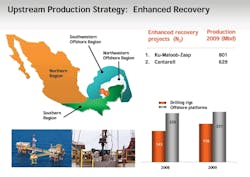Pemex turns to deepwater to reduce decline
Eldon Ball
Senior Editor, Technology & Economics
Petroleos Mexicanos (Pemex), the Mexican national oil company, finds itself in the midst of a classic good-news/bad-news scenario.
The bad news begins with the fact that production from its giant offshore Cantarell field continues to fall, with corresponding declines in revenue. Total Pemex production in 2009 fell by 7.3% – most of the loss coming from Cantarell.
To add to the gloom, Pemex may be facing the prospect of importing oil for the first time in over 30 years. The state oil company says the imported oil would feed domestic refineries, which are running below capacity, and reduce Mexico’s reliance on imported fuels. Demand for gasoline and diesel exceeds 500,000 b/d. Falling oil production could turn Mexico into a net oil importer before 2020, but the current import proposal is said to be aimed at improving refinery profitability. Nevertheless, it marks a turning point in Mexico’s oil policy and is bad news both financially and politically. Production declines have reduced Mexico’s annual government budget and credit rating.
If that is not enough bad news, recurring violence from the drug cartels that menace parts of the country disrupts work and affects morale on some projects in Mexico. Earlier this year, five workers were kidnapped at the front gate of the Gigante No. 1 natural gas plant in the Burgos basin. They have not been heard from since. Another 30 other employees of contractors in the same region have been reported missing. Analysts are speculating that the “Nigerian method” is being exported to Mexico – referring to the Nigerian Movement for the Emancipation of the Nigerian Delta (MEND) that has targeted oil and gas installations in that country.
Good news
The good news is that, in the face of all the bad news, Pemex has recently invited outside operators to join them in finding and developing offshore oil and gas resources, particularly in deepwater.
Pemex announced last month that it may offer four exploration and production contracts immediately and three more by the end of the year. Terms of the contracts to be offered are not yet clear, but Carlos Morales, chief of Exploration and Production, told Bloomberg News that “bonuses” will be paid to outside operators based on the volume and speed of oil recovered and the safety of the projects.
Pemex says it expects IOCs such as ExxonMobil, Royal Dutch Shell, and Chevron to help develop offshore reserves. The new policy toward outside operators was made possible after changes to Mexico’s oil laws in 2008 allowed it to hire foreign companies and they were announced – perhaps not coincidentally – following a moratorium on US offshore deepwater drilling.
(Above) Pemex has announced that it will spend $269 billion by 2019 to reverse declines and increase production. Source: Pemex. (Below) Pemex expects deepwater production to start by 2015. Source: Pemex.
In the past, Pemex has relied on contractors and service companies for assistance in developing hydrocarbon reserves, but by constitutional law and public opinion it could not allow outside operators to conduct business in Mexico. The proposed new contracts will allow Pemex to work with companies with deepwater exploration experience, and will attract new financial sources for investments, the company says.
Pemex needs the exploration and production proficiency for some fields more than the equipment, Morales said. However, since outside oil companies are not allowed to own the oil or book the reserves, it is unclear if they will be eager to partner with Pemex.
Assuming that experienced deepwater operators join forces with Pemex, the company says it expects deepwater production to start by 2015. It has announced a set of strategies to reach that goal:
- Accelerate incorporation of proven reserves
- Accelerate the start of production
- Strengthen technical abilities
- Increase execution capacity
- Ensure availability of drilling rigs required to carry out the activities considered in the investment portfolio.
More good news
Meanwhile, Pemex has announced that it will spend $269 billion by 2019 to increase production. Pemex recently presented a 2011 budget proposal, including non-investment expenditure, of 400 billion pesos ($31 billion) to the Finance Ministry, up from the 260 billion earmarked for this year. About 80% of its investments will be allocated to exploration and production, the company says.
Another piece of good news for Pemex is that production is ahead of schedule at the Ku-Maloob-Zaap (KMZ) complex in the Bay of Campeche.
Pemex discovered the KMZ field northwest of Cantarell in the Bay of Campeche in 1979. The field, 105 km (65 mi) from Ciudad del Carmen, is comprised of three relatively large fields – Ku, Maloob, and Zaap. Pemex’s development plan consisted of drilling up to 82 fields and installing 17 production platforms, as well as installing an oil pipeline of 166 km (103 mi) length to transport production to shore. It expected that by 2011, production would reach 800,000 b/d (130,000 cu m/d) of oil and 282 MMcf/d (8 MMcu m/d) of natural gas.
By November 2009, the field had already surpassed those targets. Oil production was 802,002 b/d and, as a result of production declines at the Cantarell field, KMZ became Mexico’s most productive oil field.
Controlling the decline
At Cantarell, Pemex’s strategy is to manage the decline. Cantarell’s original high production rate resulted primarily from a natural gas bubble that maintained pressure within the reservoir. Over a period of time, reservoir pressure fell. In 2004, Pemex recognized that output from the field would decline steeply beginning in 2006 at a rate of about 14% a year.
In 2006, output fell by 13.1%, and in 2008 it fell another 33%. Pemex invested 38 billion pesos ($2.88 billion) in 2008 to install 20 wells and dehydration and desalination plants at Cantarell to mitigate the decline.
Pemex says these efforts already have resulted in a reduced rate of decline in production in recent months compared to previous years.
Although reducing the rate of decline in production is important, that alone will not solve Mexico’s oil woes. It remains to be seen going forward how the possible introduction of experienced deepwater operators into Pemex’s strategy for developing new reserves may play out. It is at least one indicator that Mexico may be moving to a new era in national oil policy.
Offshore Articles Archives
View Oil and Gas Articles on PennEnergy.com


